Critical Race Theory and Grounded Theory in Education Research
VerifiedAdded on 2022/08/11
|8
|1523
|26
Report
AI Summary
This report investigates the school-to-prison pipeline, a phenomenon where students, particularly those of color, are funneled out of schools and into the juvenile and criminal justice systems. The study employs Critical Race Theory (CRT) to analyze how racial inequalities and discrimination contribute to this issue, examining the systemic practices that disproportionately affect marginalized groups. Grounded Theory is used as the research methodology, emphasizing data collection and analysis to develop a comprehensive understanding of the problem. The report includes a literature review that highlights the historical context and definitions of the school-to-prison pipeline, as well as the role of school policies, law enforcement, and educational practices in criminalizing students. The research plan outlines the use of grounded theory, including data collection methods and analysis strategies such as coding, conceptualization, categorization, and integration of findings to explore the relationship between race and the criminalization of students in American schools. The expected outcomes include identifying discriminatory practices and understanding the factors contributing to student criminalization.
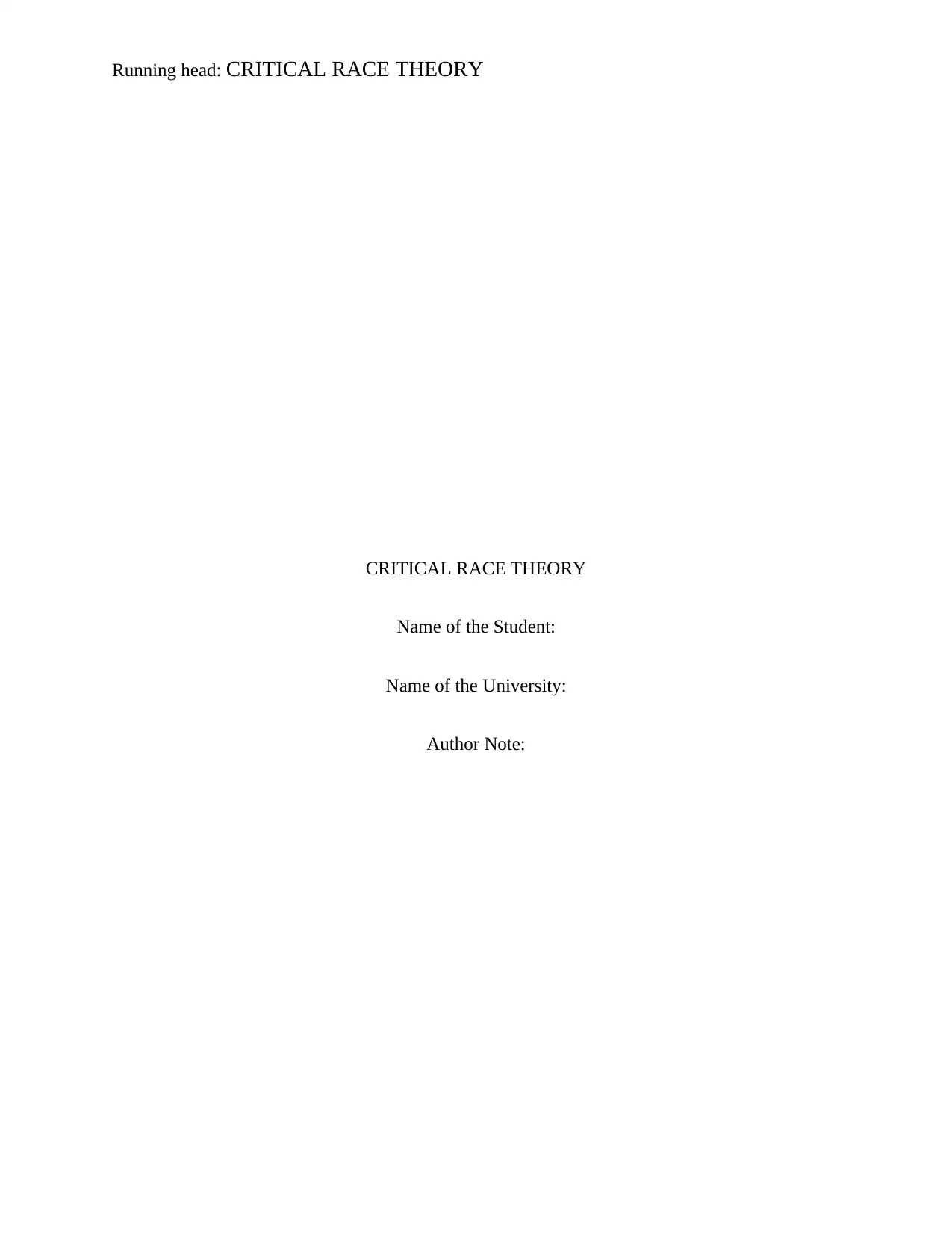
Running head: CRITICAL RACE THEORY
CRITICAL RACE THEORY
Name of the Student:
Name of the University:
Author Note:
CRITICAL RACE THEORY
Name of the Student:
Name of the University:
Author Note:
Paraphrase This Document
Need a fresh take? Get an instant paraphrase of this document with our AI Paraphraser
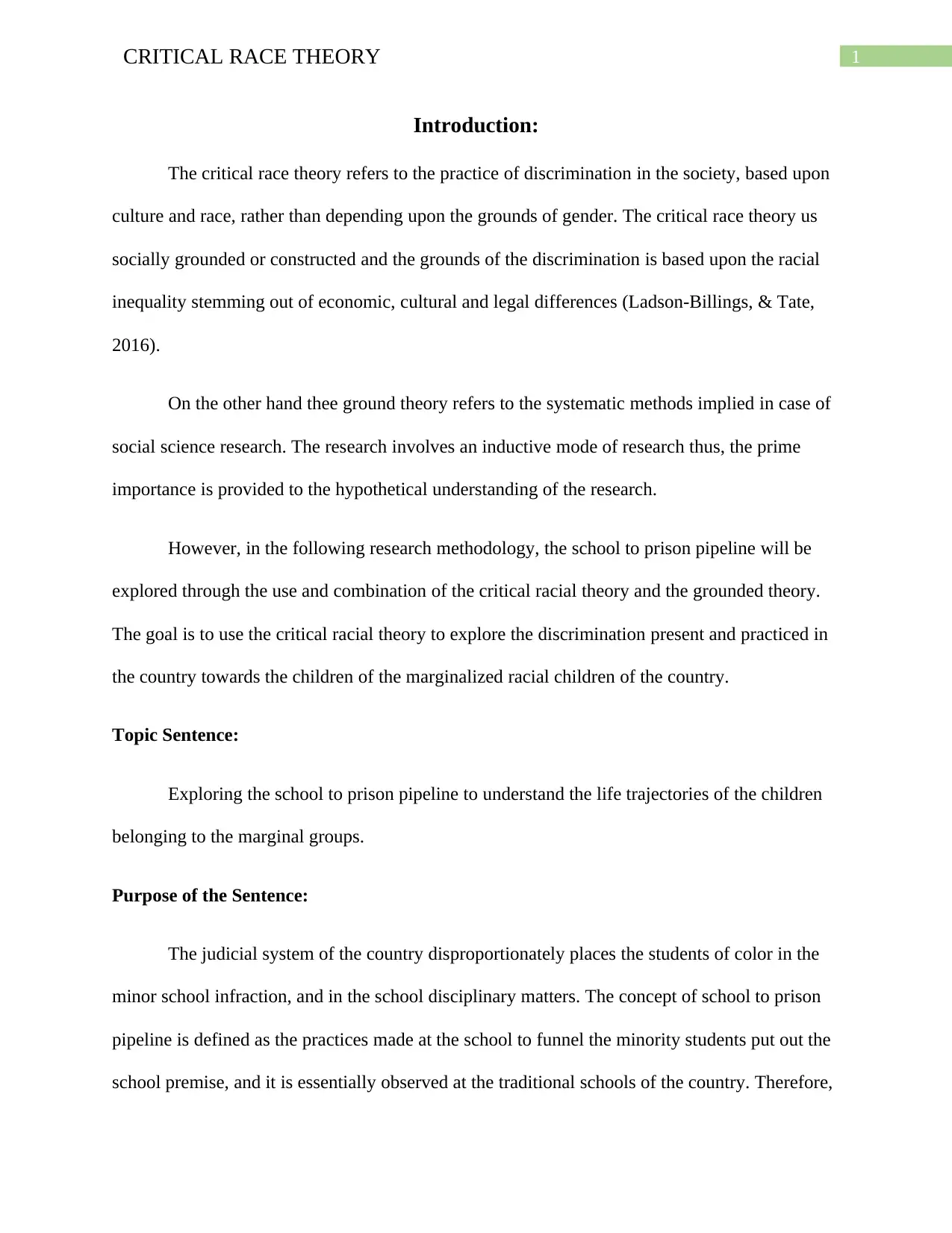
1CRITICAL RACE THEORY
Introduction:
The critical race theory refers to the practice of discrimination in the society, based upon
culture and race, rather than depending upon the grounds of gender. The critical race theory us
socially grounded or constructed and the grounds of the discrimination is based upon the racial
inequality stemming out of economic, cultural and legal differences (Ladson-Billings, & Tate,
2016).
On the other hand thee ground theory refers to the systematic methods implied in case of
social science research. The research involves an inductive mode of research thus, the prime
importance is provided to the hypothetical understanding of the research.
However, in the following research methodology, the school to prison pipeline will be
explored through the use and combination of the critical racial theory and the grounded theory.
The goal is to use the critical racial theory to explore the discrimination present and practiced in
the country towards the children of the marginalized racial children of the country.
Topic Sentence:
Exploring the school to prison pipeline to understand the life trajectories of the children
belonging to the marginal groups.
Purpose of the Sentence:
The judicial system of the country disproportionately places the students of color in the
minor school infraction, and in the school disciplinary matters. The concept of school to prison
pipeline is defined as the practices made at the school to funnel the minority students put out the
school premise, and it is essentially observed at the traditional schools of the country. Therefore,
Introduction:
The critical race theory refers to the practice of discrimination in the society, based upon
culture and race, rather than depending upon the grounds of gender. The critical race theory us
socially grounded or constructed and the grounds of the discrimination is based upon the racial
inequality stemming out of economic, cultural and legal differences (Ladson-Billings, & Tate,
2016).
On the other hand thee ground theory refers to the systematic methods implied in case of
social science research. The research involves an inductive mode of research thus, the prime
importance is provided to the hypothetical understanding of the research.
However, in the following research methodology, the school to prison pipeline will be
explored through the use and combination of the critical racial theory and the grounded theory.
The goal is to use the critical racial theory to explore the discrimination present and practiced in
the country towards the children of the marginalized racial children of the country.
Topic Sentence:
Exploring the school to prison pipeline to understand the life trajectories of the children
belonging to the marginal groups.
Purpose of the Sentence:
The judicial system of the country disproportionately places the students of color in the
minor school infraction, and in the school disciplinary matters. The concept of school to prison
pipeline is defined as the practices made at the school to funnel the minority students put out the
school premise, and it is essentially observed at the traditional schools of the country. Therefore,

2CRITICAL RACE THEORY
the critical racial theory has tried to focus on this subject and has tried to provide an
understanding of the practices of the inequality between the dominant and marginalized racial
groups (Redfield, & Nance, 2016). The principles of the Ground theory will be used to explain
the topic, collect the data and finally to get the results and to evaluate the same. Therefore, firstly
a brief literature review is provided and then the grounded methodology, which is effectively
used, has been analyzed.
Literature Review:
The concepts of school to prison pipeline had come into the picture with a publication of
the Northern University in 2003. The concept had gained population since the initial
development and the significance of the concepts and the practices was recognized by the
American Civil Liberties Union, and it conceptualized the term schoolhouse to jailhouse track
(Atkins, & Oglesby, 2018). Further the American Federation of Teachers, National Education
Association and the administration phase of Barrack Obama the concept had gained its widest
popularity. There are a number of definitions of the concept, and the most popular one had been
identified by McGrew, (2016). The researchers identified the concepts as process of students
being pushed out of the educational institutions to the prisons, by criminalizing the students. The
law encounter officer and the educational policies and practices used by the educational students
take a major and important part in the criminalizing the students (Crawley, & Hirschfield, 2018).
Researchers have identified that it is more likely that the children of color are usually
pushed out and criminalized, the reports from the juvenile institutions and the educational
institutions have reported the same. The researchers have further found that the schools of the
American system has the history of identifying the students of color being involved in criminal
the critical racial theory has tried to focus on this subject and has tried to provide an
understanding of the practices of the inequality between the dominant and marginalized racial
groups (Redfield, & Nance, 2016). The principles of the Ground theory will be used to explain
the topic, collect the data and finally to get the results and to evaluate the same. Therefore, firstly
a brief literature review is provided and then the grounded methodology, which is effectively
used, has been analyzed.
Literature Review:
The concepts of school to prison pipeline had come into the picture with a publication of
the Northern University in 2003. The concept had gained population since the initial
development and the significance of the concepts and the practices was recognized by the
American Civil Liberties Union, and it conceptualized the term schoolhouse to jailhouse track
(Atkins, & Oglesby, 2018). Further the American Federation of Teachers, National Education
Association and the administration phase of Barrack Obama the concept had gained its widest
popularity. There are a number of definitions of the concept, and the most popular one had been
identified by McGrew, (2016). The researchers identified the concepts as process of students
being pushed out of the educational institutions to the prisons, by criminalizing the students. The
law encounter officer and the educational policies and practices used by the educational students
take a major and important part in the criminalizing the students (Crawley, & Hirschfield, 2018).
Researchers have identified that it is more likely that the children of color are usually
pushed out and criminalized, the reports from the juvenile institutions and the educational
institutions have reported the same. The researchers have further found that the schools of the
American system has the history of identifying the students of color being involved in criminal
⊘ This is a preview!⊘
Do you want full access?
Subscribe today to unlock all pages.

Trusted by 1+ million students worldwide
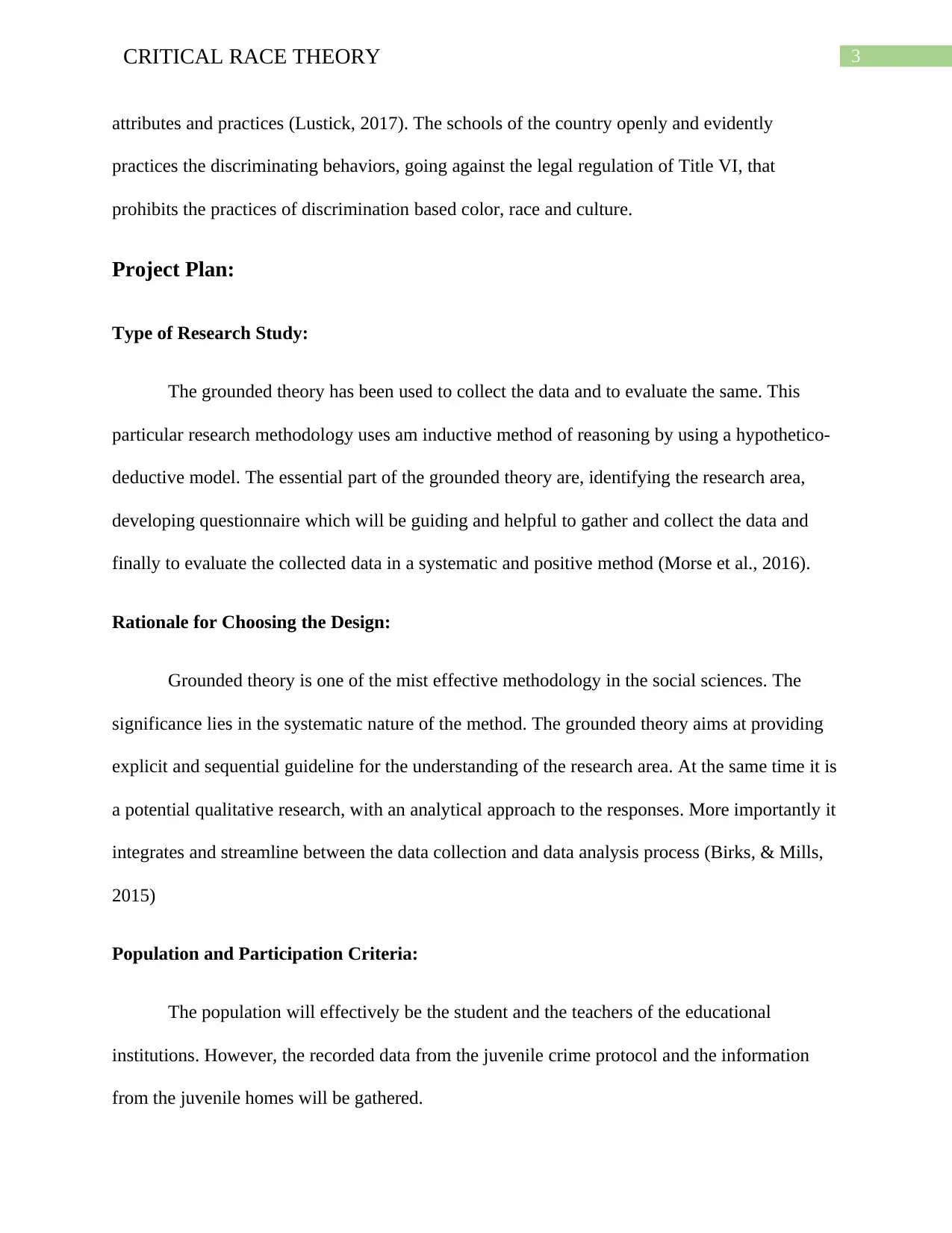
3CRITICAL RACE THEORY
attributes and practices (Lustick, 2017). The schools of the country openly and evidently
practices the discriminating behaviors, going against the legal regulation of Title VI, that
prohibits the practices of discrimination based color, race and culture.
Project Plan:
Type of Research Study:
The grounded theory has been used to collect the data and to evaluate the same. This
particular research methodology uses am inductive method of reasoning by using a hypothetico-
deductive model. The essential part of the grounded theory are, identifying the research area,
developing questionnaire which will be guiding and helpful to gather and collect the data and
finally to evaluate the collected data in a systematic and positive method (Morse et al., 2016).
Rationale for Choosing the Design:
Grounded theory is one of the mist effective methodology in the social sciences. The
significance lies in the systematic nature of the method. The grounded theory aims at providing
explicit and sequential guideline for the understanding of the research area. At the same time it is
a potential qualitative research, with an analytical approach to the responses. More importantly it
integrates and streamline between the data collection and data analysis process (Birks, & Mills,
2015)
Population and Participation Criteria:
The population will effectively be the student and the teachers of the educational
institutions. However, the recorded data from the juvenile crime protocol and the information
from the juvenile homes will be gathered.
attributes and practices (Lustick, 2017). The schools of the country openly and evidently
practices the discriminating behaviors, going against the legal regulation of Title VI, that
prohibits the practices of discrimination based color, race and culture.
Project Plan:
Type of Research Study:
The grounded theory has been used to collect the data and to evaluate the same. This
particular research methodology uses am inductive method of reasoning by using a hypothetico-
deductive model. The essential part of the grounded theory are, identifying the research area,
developing questionnaire which will be guiding and helpful to gather and collect the data and
finally to evaluate the collected data in a systematic and positive method (Morse et al., 2016).
Rationale for Choosing the Design:
Grounded theory is one of the mist effective methodology in the social sciences. The
significance lies in the systematic nature of the method. The grounded theory aims at providing
explicit and sequential guideline for the understanding of the research area. At the same time it is
a potential qualitative research, with an analytical approach to the responses. More importantly it
integrates and streamline between the data collection and data analysis process (Birks, & Mills,
2015)
Population and Participation Criteria:
The population will effectively be the student and the teachers of the educational
institutions. However, the recorded data from the juvenile crime protocol and the information
from the juvenile homes will be gathered.
Paraphrase This Document
Need a fresh take? Get an instant paraphrase of this document with our AI Paraphraser
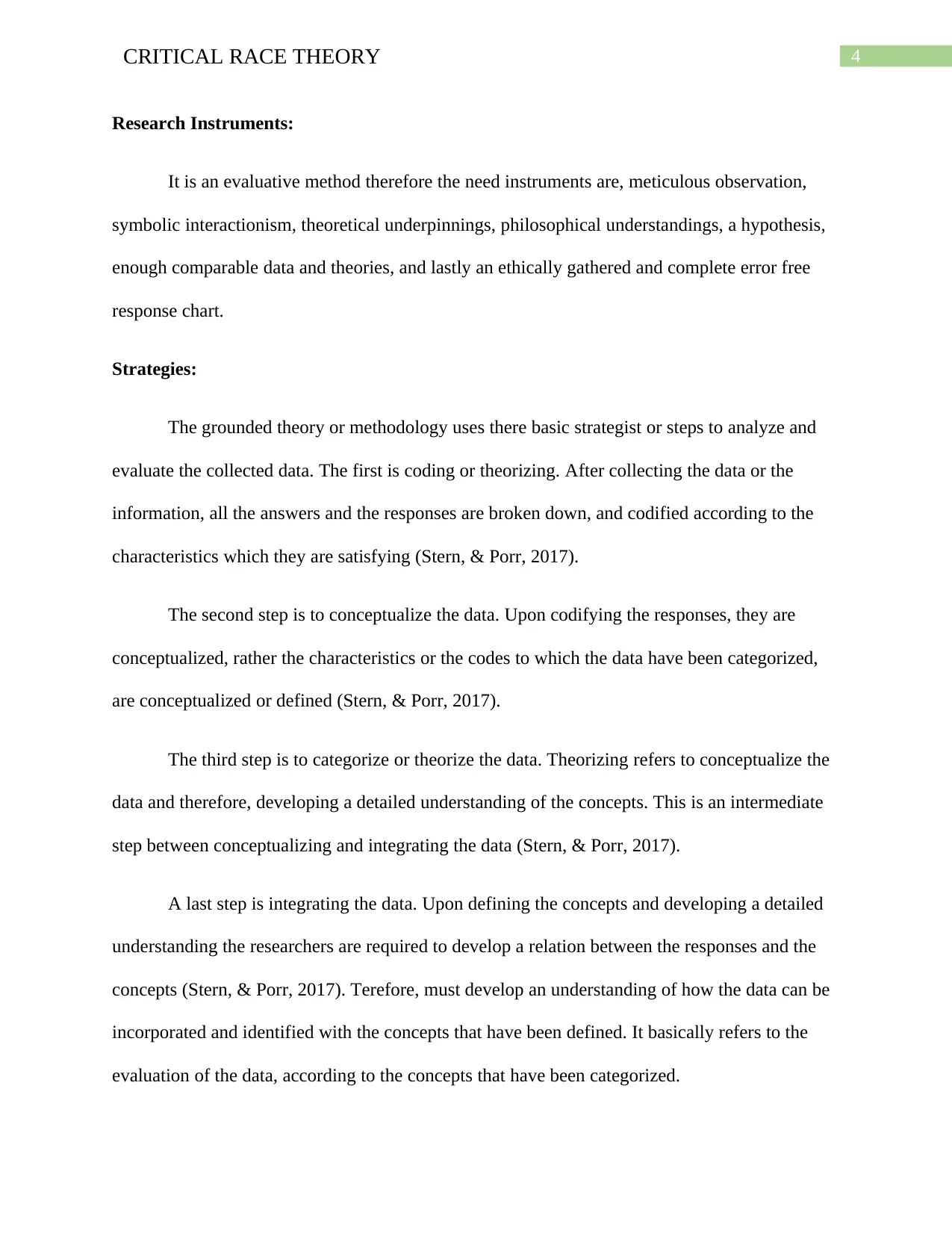
4CRITICAL RACE THEORY
Research Instruments:
It is an evaluative method therefore the need instruments are, meticulous observation,
symbolic interactionism, theoretical underpinnings, philosophical understandings, a hypothesis,
enough comparable data and theories, and lastly an ethically gathered and complete error free
response chart.
Strategies:
The grounded theory or methodology uses there basic strategist or steps to analyze and
evaluate the collected data. The first is coding or theorizing. After collecting the data or the
information, all the answers and the responses are broken down, and codified according to the
characteristics which they are satisfying (Stern, & Porr, 2017).
The second step is to conceptualize the data. Upon codifying the responses, they are
conceptualized, rather the characteristics or the codes to which the data have been categorized,
are conceptualized or defined (Stern, & Porr, 2017).
The third step is to categorize or theorize the data. Theorizing refers to conceptualize the
data and therefore, developing a detailed understanding of the concepts. This is an intermediate
step between conceptualizing and integrating the data (Stern, & Porr, 2017).
A last step is integrating the data. Upon defining the concepts and developing a detailed
understanding the researchers are required to develop a relation between the responses and the
concepts (Stern, & Porr, 2017). Terefore, must develop an understanding of how the data can be
incorporated and identified with the concepts that have been defined. It basically refers to the
evaluation of the data, according to the concepts that have been categorized.
Research Instruments:
It is an evaluative method therefore the need instruments are, meticulous observation,
symbolic interactionism, theoretical underpinnings, philosophical understandings, a hypothesis,
enough comparable data and theories, and lastly an ethically gathered and complete error free
response chart.
Strategies:
The grounded theory or methodology uses there basic strategist or steps to analyze and
evaluate the collected data. The first is coding or theorizing. After collecting the data or the
information, all the answers and the responses are broken down, and codified according to the
characteristics which they are satisfying (Stern, & Porr, 2017).
The second step is to conceptualize the data. Upon codifying the responses, they are
conceptualized, rather the characteristics or the codes to which the data have been categorized,
are conceptualized or defined (Stern, & Porr, 2017).
The third step is to categorize or theorize the data. Theorizing refers to conceptualize the
data and therefore, developing a detailed understanding of the concepts. This is an intermediate
step between conceptualizing and integrating the data (Stern, & Porr, 2017).
A last step is integrating the data. Upon defining the concepts and developing a detailed
understanding the researchers are required to develop a relation between the responses and the
concepts (Stern, & Porr, 2017). Terefore, must develop an understanding of how the data can be
incorporated and identified with the concepts that have been defined. It basically refers to the
evaluation of the data, according to the concepts that have been categorized.
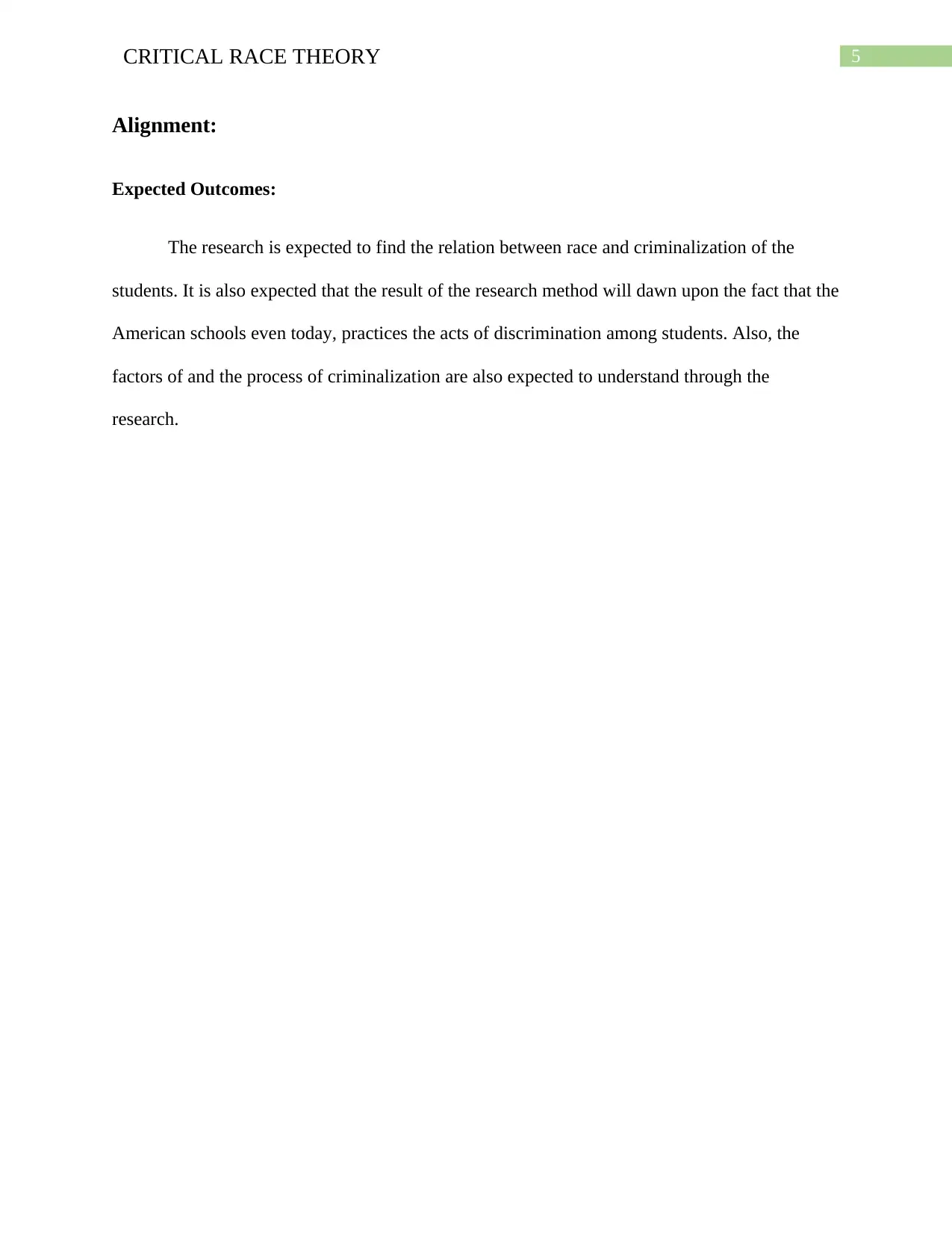
5CRITICAL RACE THEORY
Alignment:
Expected Outcomes:
The research is expected to find the relation between race and criminalization of the
students. It is also expected that the result of the research method will dawn upon the fact that the
American schools even today, practices the acts of discrimination among students. Also, the
factors of and the process of criminalization are also expected to understand through the
research.
Alignment:
Expected Outcomes:
The research is expected to find the relation between race and criminalization of the
students. It is also expected that the result of the research method will dawn upon the fact that the
American schools even today, practices the acts of discrimination among students. Also, the
factors of and the process of criminalization are also expected to understand through the
research.
⊘ This is a preview!⊘
Do you want full access?
Subscribe today to unlock all pages.

Trusted by 1+ million students worldwide
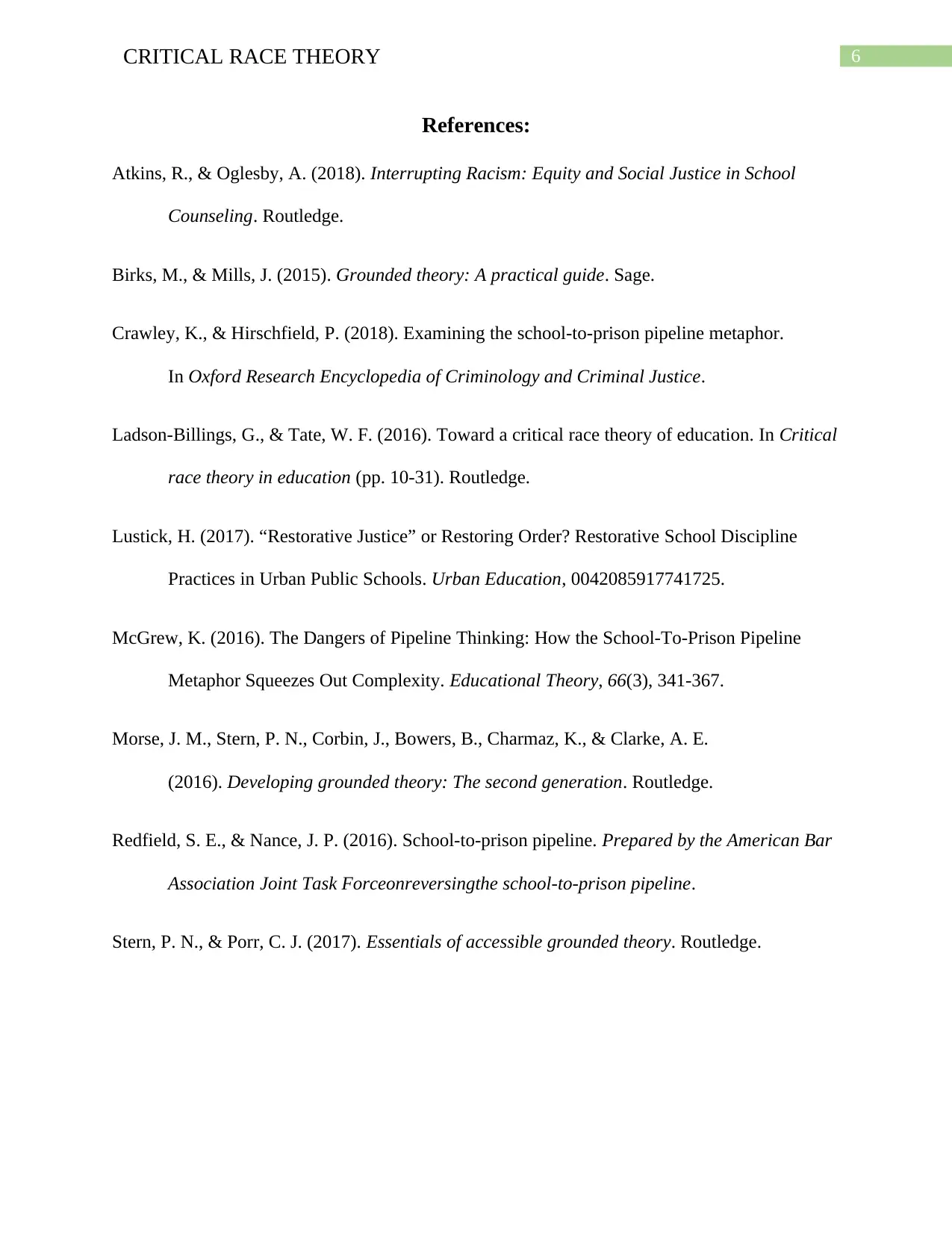
6CRITICAL RACE THEORY
References:
Atkins, R., & Oglesby, A. (2018). Interrupting Racism: Equity and Social Justice in School
Counseling. Routledge.
Birks, M., & Mills, J. (2015). Grounded theory: A practical guide. Sage.
Crawley, K., & Hirschfield, P. (2018). Examining the school-to-prison pipeline metaphor.
In Oxford Research Encyclopedia of Criminology and Criminal Justice.
Ladson-Billings, G., & Tate, W. F. (2016). Toward a critical race theory of education. In Critical
race theory in education (pp. 10-31). Routledge.
Lustick, H. (2017). “Restorative Justice” or Restoring Order? Restorative School Discipline
Practices in Urban Public Schools. Urban Education, 0042085917741725.
McGrew, K. (2016). The Dangers of Pipeline Thinking: How the School‐To‐Prison Pipeline
Metaphor Squeezes Out Complexity. Educational Theory, 66(3), 341-367.
Morse, J. M., Stern, P. N., Corbin, J., Bowers, B., Charmaz, K., & Clarke, A. E.
(2016). Developing grounded theory: The second generation. Routledge.
Redfield, S. E., & Nance, J. P. (2016). School-to-prison pipeline. Prepared by the American Bar
Association Joint Task Forceonreversingthe school-to-prison pipeline.
Stern, P. N., & Porr, C. J. (2017). Essentials of accessible grounded theory. Routledge.
References:
Atkins, R., & Oglesby, A. (2018). Interrupting Racism: Equity and Social Justice in School
Counseling. Routledge.
Birks, M., & Mills, J. (2015). Grounded theory: A practical guide. Sage.
Crawley, K., & Hirschfield, P. (2018). Examining the school-to-prison pipeline metaphor.
In Oxford Research Encyclopedia of Criminology and Criminal Justice.
Ladson-Billings, G., & Tate, W. F. (2016). Toward a critical race theory of education. In Critical
race theory in education (pp. 10-31). Routledge.
Lustick, H. (2017). “Restorative Justice” or Restoring Order? Restorative School Discipline
Practices in Urban Public Schools. Urban Education, 0042085917741725.
McGrew, K. (2016). The Dangers of Pipeline Thinking: How the School‐To‐Prison Pipeline
Metaphor Squeezes Out Complexity. Educational Theory, 66(3), 341-367.
Morse, J. M., Stern, P. N., Corbin, J., Bowers, B., Charmaz, K., & Clarke, A. E.
(2016). Developing grounded theory: The second generation. Routledge.
Redfield, S. E., & Nance, J. P. (2016). School-to-prison pipeline. Prepared by the American Bar
Association Joint Task Forceonreversingthe school-to-prison pipeline.
Stern, P. N., & Porr, C. J. (2017). Essentials of accessible grounded theory. Routledge.
Paraphrase This Document
Need a fresh take? Get an instant paraphrase of this document with our AI Paraphraser
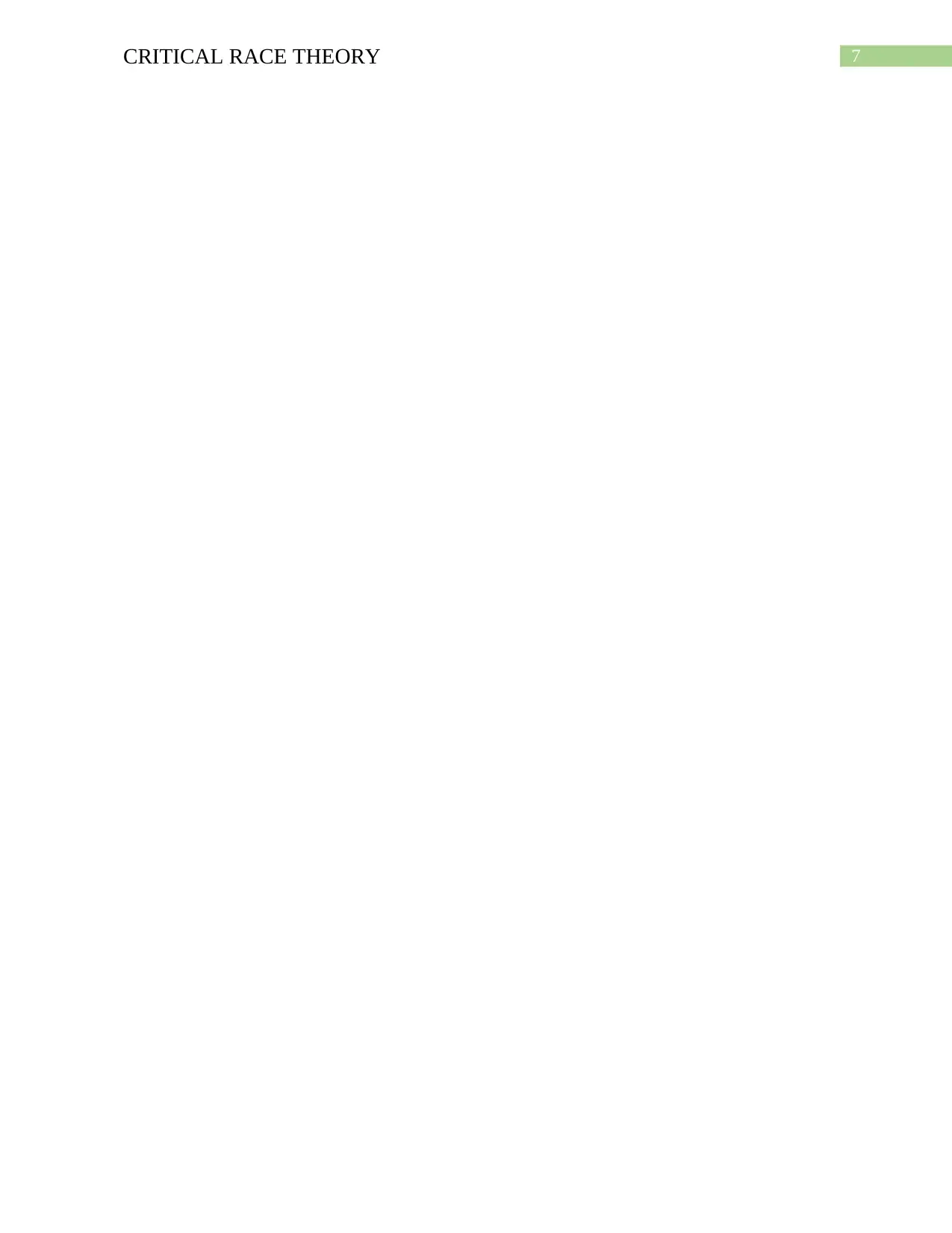
7CRITICAL RACE THEORY
1 out of 8
Related Documents
Your All-in-One AI-Powered Toolkit for Academic Success.
+13062052269
info@desklib.com
Available 24*7 on WhatsApp / Email
![[object Object]](/_next/static/media/star-bottom.7253800d.svg)
Unlock your academic potential
Copyright © 2020–2025 A2Z Services. All Rights Reserved. Developed and managed by ZUCOL.





